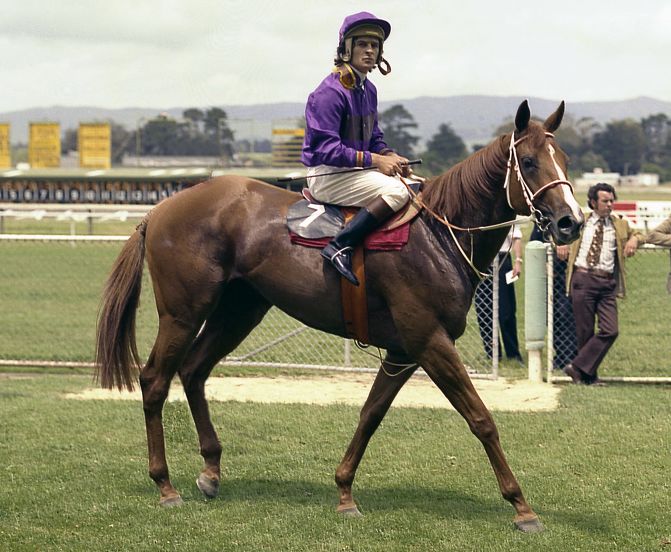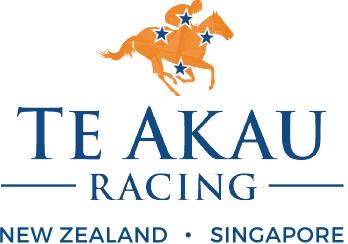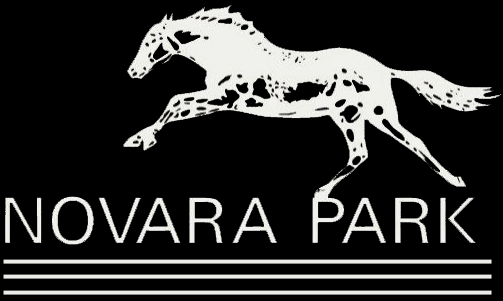 Champion racemare La Mer and her regular rider Des Harris.
Champion racemare La Mer and her regular rider Des Harris.More than four decades have passed since champion racemare La Mer graced the New Zealand turf, however her influence continues across the racing world.
The winner of 24 of her 43 starts from 1976 to 1979, champion two-year-old, 1977 Filly of the Year and 1979 New Zealand Horse of the Year, La Mer was sold in controversial circumstances at the end of her racing career and spent her remaining days as a broodmare in Ireland.
While she was unable to impart her extreme ability to any of her progeny, the line founded by La Mer has continued to be a source of quality gallopers through subsequent generations. Benbatl, who traces through four generations to her, was an international star late last decade with a record headed by Group One wins in Dubai, Germany and Australia. Now Benbatl’s seven-year younger sibling Elmalka has added her name to the family roll of honour by winning last Saturday’s English 1000 Guineas.
Benbatl and Elmalka, whose respective sires are the champions Dubawi and Kingman, are among five winners produced by Nahrain, a daughter of Selkirk who won Group One races on both sides of the Atlantic. Nahrain delivered the first Group One success for her trainer Roger Varian when she won the Longchamp Prix de l’Opera in 2011, and 13 years later the circle was completed by her daughter at Newmarket when she came from last to claim a narrow victory in the 1000 Guineas.
The story around this celebrated family goes back in a New Zealand context nearly 60 years. At the time Jack Alexander, a foundation member of the New Zealand Thoroughbred Breeders’ Association, operated Cranleigh Stud in the Wanganui region.
Alexander’s model included the importation of mares from Europe, amongst them the Acropolis mare Olgiata, who landed in New Zealand carrying a foal by the Washington DC International Stakes winner Worden ll. The filly that resulted, La Balsa, was unraced, but she went on to make her name as a broodmare.
Alexander never got to benefit personally from his inspired choice, having put his bloodstock up for sale in the Cranleigh Stud dispersal in 1974, three years before he passed away. The beneficiary was Taranaki breeder Allen Alexander, who added La Balsa to his broodmare band at Wynthorpe Stud, Waitara, where champion stallion Copenhagen ll held court. The son of Royal Charger topped the New Zealand sires’ premiership four times between 1968 and 1976.
The inevitable mating of Copenhagen and La Balsa was to produce the slightly built chestnut filly with a white blaze who became famous as La Mer. Under the training of Malcolm Smith, who at the time was based at Bell Block on the eastern outskirts of New Plymouth, she capped her two-year-old season with victory in the 1976 Manawatu Sires’ Produce Stakes.
At three years she doubled down on that with a sequence that began with the Gold Trail Stakes, continued through the Desert Gold, Eulogy and Royal Stakes and was completed by the New Zealand Oaks-Great Northern Oaks double.
At four and five years La Mer got the chance to prove herself across the Tasman, but even though she won the Coongy Handicap and finished second in the LKS Mackinnon Stakes, Australian racegoers never got to see the best of her.
Perhaps she was a home-body, as she was to prove time and time again on New Zealand tracks, and in some of those wins putting up performances that arguably no other horse would have been able to match.
Her career-defining win came in the Gr. 1 Air New Zealand Stakes at Ellerslie in the autumn of 1979. With regular rider Des Harris placing his faith fully in the potent sprint that had overwhelmed so many rivals, she settled last of the 16 runners in the 2000m weight-for age classic.
La Mer was still in the rear as the field swung for home, but in a flash she was through and setting out after the leaders. She reeled them in and easily held off the challenge of Shivaree to win by more than two lengths.
By this time Allen Alexander had died, and La Mer along with other bloodstock had been bequeathed to New Plymouth Boys’ High School for the benefit of pupils studying agriculture. La Mer was by far the most valuable member of the Alexander portfolio and it was perhaps understandable that her value should be realised by the management trust.
Finding a buyer was understandably not difficult, but there was a hue and cry when it was revealed that the buyer, at a reported $300,000, was Anglo-Irishman Captain Tim Rogers, whose extensive breeding interests included Grangewilliam Stud near Wanganui and Airlie Stud in County Kildare, Ireland.
In the late 1970s I was editor of the monthly breeding magazine Bloodhorse, and my reaction to La Mer’s loss to the New Zealand breeding industry was to editorialise on the merits of establishing a National Stud along similar lines to the long-standing English and Irish versions.
Call it youthful naivety – I was after all only in my mid-20s at the time – but a New Zealand National Stud or any type of breeders’ co-operative to invest in our best bloodstock was never going to happen. The upshot of La Mer’s sale to Rogers was that she established a line that is now like the breeding world – truly global.
One of her daughters, the Artaius filly Loughmore, was repatriated to Grangewilliam and raced on lease by then Prime Minister Sir Robert Muldoon and Wellington lawyer Des Dalgety. She won just once under the training of Don Sellwood, but became the granddam of Little Jamie, whose win for Paul O’Sullivan in the 2000 Manawatu Sires’ Produce Stakes came 24 years after La Mer had claimed her first Group One win in the same Awapuni two-year-old feature.
La Mer did at least produce seven winners from her 10 foals to race, the best of them the Irish Listed winner Cipriani, while another descending from Loughmore was the Karyn McQuade-trained Tauranga Classic winner Ascot Isle.
The La Mer line can also take credit for the 2016 Gr. 1 Toorak Handicap winner He’s Our Rokkii, while Northern Hemisphere performers besides Nahrain and her progeny Elmalka and Benbatl include Nahrain’s Group Two-winning dam Bahr and Maximus Boy, whose wins included the Gr. 2 Istanbul Bosphorus Cup in Turkey.
The list doesn’t end there, but it’s quite clear that La Mer’s loss to Ireland all those years ago was by no means at the expense of the international thoroughbred gene pool.










